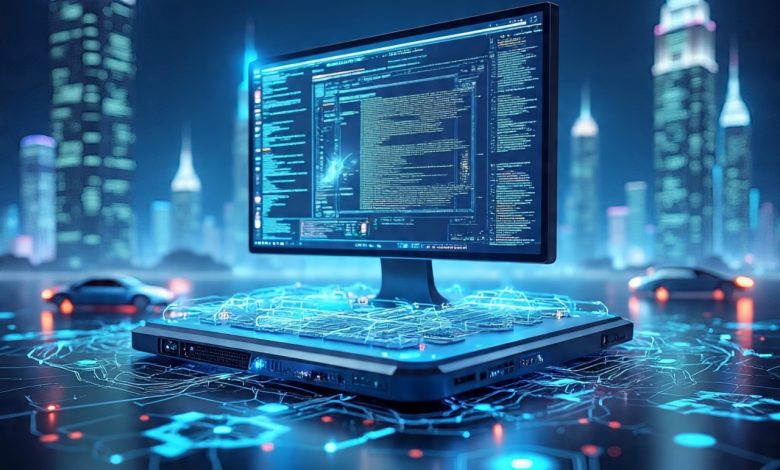
I’ve been working in digital tech and SEO for years now, and there’s one topic that always makes me pause and go, “Wow, we’ve come a long way”—and that’s Computing. Specifically, how it drives Artificial Intelligence (AI). You see, computing isn’t just about crunching numbers anymore. It’s become the engine behind everything AI does—from understanding human language to diagnosing diseases.
What really pushed me to write this article was a moment during a recent project when I realized how even a small tweak in computing power could completely transform an AI model’s accuracy. That’s when it hit me—most people don’t realize how deep this connection goes.
So in this post, I’m not just going to throw around terms like CPUs and GPUs. I’ll break down how computing is the real powerhouse behind AI, why it matters, and what that means for the future. Whether you’re curious, building something with AI, or just want to understand the tech better—this is for you.
1. What Is Computing in the Context of AI?
Let’s start simple. When I say computing, I’m talking about the systems and processes that allow machines to process data. It includes everything from the physical hardware—like processors and memory—to the software infrastructure that manages tasks.
In AI, computing is the backbone. Without powerful computing systems, AI wouldn’t exist in the form we know it today. You wouldn’t have ChatGPT, self-driving cars, facial recognition, or even Spotify’s personalized recommendations.
Quick Tip: Think of computing as the “muscle” and AI algorithms as the “brain.” You need both to make things work.
2. The Evolution of Computing for AI
Now here’s where it gets fascinating. When I first dipped my toes into machine learning, I was working with regular CPUs (Central Processing Units). They worked—but were painfully slow for training models.
Then came GPUs (Graphics Processing Units), and everything changed. GPUs can perform thousands of simultaneous operations, which makes them perfect for training AI. This led to breakthroughs in deep learning, natural language processing, and more.
Here’s a quick look at how the computing landscape evolved for AI:
| Era | Hardware Used | AI Capability Level |
|---|---|---|
| Pre-2010 | CPUs | Basic ML algorithms |
| 2010–2015 | GPUs | Deep learning explosion |
| 2016–2020 | TPUs, Parallel Computing | Complex neural networks |
| 2021–Now | Edge Computing, Quantum Trials | Real-time AI, Generative AI |
Guide: If you’re experimenting with AI, upgrading from CPU to GPU (or better yet, TPU) can cut training time by up to 80%. Seriously—it’s a game-changer.
3. Key Types of Computing That Fuel AI
Here are the main computing systems I use or recommend for different AI applications:
a. Central Processing Units (CPUs)
-
Best for: Simple models, small datasets, or inference tasks.
-
Limitation: Too slow for deep learning training.
-
Real-world example: Basic image classification on a laptop.
b. Graphics Processing Units (GPUs)
-
Best for: Training deep neural networks.
-
Power: Handles thousands of calculations at once.
-
Real-world example: Used by OpenAI, Google, and Meta for large AI projects.
c. Tensor Processing Units (TPUs)
-
Custom chips by Google made specifically for AI.
-
Extremely fast for both training and inference.
-
According to Google Cloud, TPUs can be up to 15–30 times faster than GPUs for certain tasks.
d. Quantum Computing (Emerging)
-
Still in early stages but holds promise.
-
Could solve problems regular computing can’t, like simulating molecules.
Note: If you’re just starting, you don’t need a TPU or quantum setup. But using cloud-based GPU platforms like Google Colab or AWS SageMaker is a smart move.
4. How Computing Directly Impacts AI Accuracy
This is something I learned the hard way: AI performance isn’t just about the algorithm—it’s about the hardware. Here’s why:
a. Faster Computing = More Data Processed
When you have powerful processors, you can feed AI more data. And more data means better learning and fewer errors.
b. Real-Time Decisions
In industries like finance or healthcare, decisions must be made instantly. Strong computing systems allow AI to respond in real-time.
c. Model Complexity
High-end computing allows you to run massive neural networks like GPT-4 or Google’s Gemini. These aren’t just complex—they’re computational monsters.
Pro Tip: Want your AI model to jump from 85% accuracy to 97%? Sometimes all it takes is training it on a better computing rig.
5. The Role of Edge Computing in Modern AI
One thing that’s exploded in recent years is Edge Computing—running AI models on local devices instead of in the cloud.
Why it matters:
-
It reduces latency.
-
Works offline.
-
Saves bandwidth.
Think smart speakers, drones, wearable health monitors. These all use edge AI.
For example, Apple’s A17 Bionic chip has a built-in Neural Engine. It can process over 35 trillion operations per second—on your phone. (Source: Apple Official)
Guide: Edge AI is perfect for apps where privacy, speed, and low-power operation matter. Don’t underestimate its potential.
6. Cloud Computing and AI Scalability
When I first launched an AI-powered tool for SEO audits, it ran fine on my local machine—until 200 people used it at once.
That’s when I learned the value of cloud computing.
Platforms like:
-
Google Cloud AI
-
AWS AI & ML
-
Microsoft Azure AI
…make it easy to scale up or down depending on demand.
Here’s why it’s gold:
-
Auto-scaling
-
Access to pre-trained models
-
Serverless deployment
You only pay for what you use, and it’s fast.
Quick Tip: If you’re building something for the public, go cloud. Local servers can’t keep up with unpredictable traffic.
7. Ethical & Energy Challenges of AI Computing
I can’t ignore this part. As much as computing helps AI grow, it also raises some red flags:
-
High Energy Consumption: Training GPT-3 reportedly used over 1,287 MWh of electricity (enough to power 120 U.S. homes for a year).
-
E-Waste: More demand = more hardware = more waste.
-
Bias in Models: Faster computing means faster mistakes if the data is biased.
Note: Always monitor the carbon footprint if you’re training large models. Tools like ML CO2 Impact calculators are super helpful.
8. What’s Next? The Future of Computing in AI
I personally think we’re only scratching the surface. Here’s what’s around the corner:
| Future Tech | Potential Impact on AI |
|---|---|
| Neuromorphic Chips | Mimic the human brain—super efficient |
| Optical Computing | Faster than electrons—light-based AI |
| Quantum AI | Breaks the limits of current AI training |
Guide: If you’re in AI or plan to be, start following emerging tech like quantum computing and neuromorphic engineering. It’ll be mainstream sooner than we think.
Conclusion
If there’s one thing I want you to take away from this—it’s that computing isn’t just some behind-the-scenes tech. It is the heartbeat of Artificial Intelligence.
Everything I’ve built in AI, every chatbot, every prediction model—it all stood on the strength of the computing systems behind it. The more I learn, the clearer it gets: better computing = better AI.
So whether you’re developing AI, using it, or just curious—understanding computing will give you a serious edge. It’s not just technical jargon. It’s the difference between OK results and groundbreaking innovation.
And in this AI-driven world, you don’t want to be on the sidelines.
FAQs
1. What is computing in the context of AI?
Computing in AI refers to the hardware and software systems that process data, run algorithms, and deliver outputs. It includes processors (CPUs, GPUs, TPUs), memory, and software infrastructure. Without computing power, AI as we know it wouldn’t exist—no chatbots, no self-driving cars, no smart recommendations. Think of computing as the muscle, while AI algorithms are the brain.
2. How has computing evolved for AI?
Early AI ran on CPUs, which worked but were too slow for large models. The introduction of GPUs allowed thousands of operations at once, triggering the deep learning boom around 2010–2015. Later, TPUs and parallel computing unlocked even more complex neural networks. Today, edge computing and quantum experiments are pushing AI into real-time and generative applications.
3. What types of computing systems are most important for AI?
-
CPUs: Best for small models or inference tasks but too slow for deep training.
-
GPUs: The workhorse of deep learning, capable of handling thousands of calculations simultaneously.
-
TPUs: Custom chips built by Google for AI, often 15–30x faster than GPUs on certain workloads.
-
Quantum Computing: Still experimental but promises to solve problems current machines can’t, like simulating molecules.
4. How does computing affect AI accuracy?
Better hardware allows models to train on more data and handle larger architectures. This leads to more accurate predictions and fewer errors. Faster processors also enable real-time decision-making in industries like healthcare or finance. In fact, sometimes the jump from 85% to 97% accuracy comes from better computing resources, not algorithm changes.
